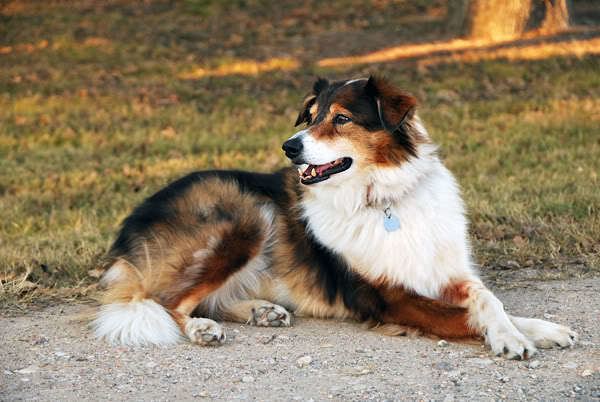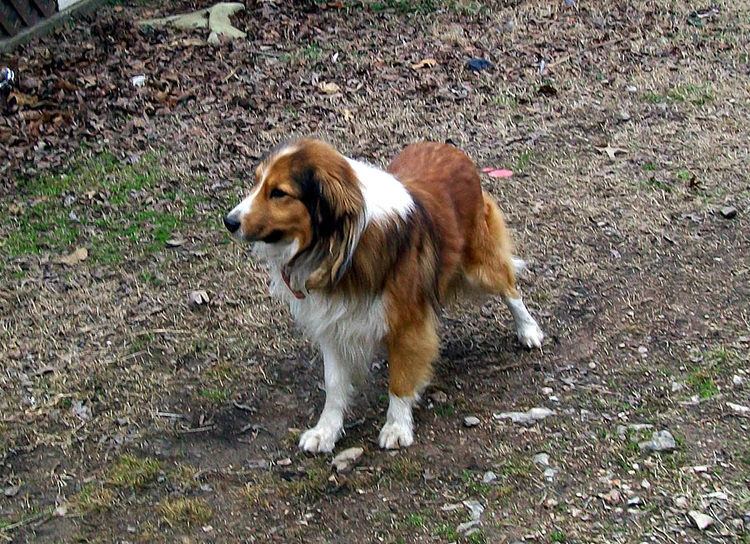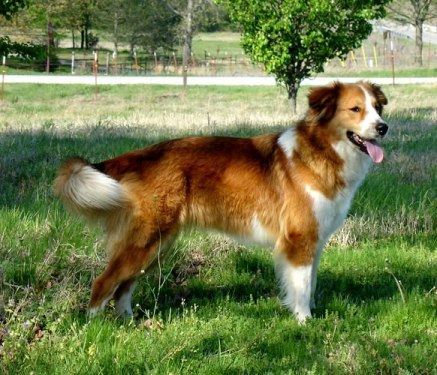Common nicknames OTFS
farm shepherd Weight Male Female 35–50 lb (16–23 kg) Higher classification Dog | Origin United States Male 45–60 lb (20–27 kg) Scientific name Canis lupus familiaris Rank Breed | |
 | ||
Breed status Not recognized as a standardized breed by any major kennel club. Similar English Shepherd, Black and Tan Virginia F, Stephens Cur, McNab dog, Hare Indian Dog | ||
The Old Time Farm Shepherd is a rare breed of working dog known for its versatility and intelligence. Old Time Farm Shepherds are the descendants of the old working Scotch Collies that were common on farms in America in the early twentieth century; as a recognized breed, they were started by J. Richard McDuffie in 1994.
Contents

Appearance
The Old Time Farm Shepherds are medium-sized, collie-type dogs with moderate coats and large, expressive eyes. They come in a range of colors including sable, tri-color, merle, and black and tan. Sable and white is the commonest color. Most Old Time Farm Shepherds are in the 40 - 50 pound range. Tails may be full or natural bob-tailed.
Temperament

The Old Time Farm Shepherd is set apart from closely related breeds by its temperament. The founder of the breed, J. Richard McDuffie described them this way "They have almost human intelligence, being able to figure things out and respond appropriately to unusual situations. They are very people-oriented but distrustful of strangers." Old Time Farm Shepherds are often very sensitive or "soft", easily trainable, eager to please but also easily damaged by harsh words.
History
In the late nineteenth and early twentieth centuries, these dogs were common on farms across America. They were called shepherds or collies. After World War II, people's fancies turned to registered dogs and the farm shepherds began a slow decline. By the 1980s, farm shepherds were almost extinct in America, McDuffie then began a nationwide search for the dogs he remembered from his youth using his column in Full Cry Magazine as a vehicle to reach out to others. From the hundreds of responses he received, he eventually located a family in Central Tennessee who had kept a line of these dogs pure for generations. In the spring of 1994 McDuffie drove to Brush Creek, Tennessee and bought the last litter of 4 pups produced by this family. McDuffie found another line of farm shepherds in Western Tennessee where he acquired 2 females. With these 6 dogs, McDuffie founded the Old Time Farm Shepherd breed and began registering them with the National Kennel Club.
As of October 2010 McDuffie's dog, Dunrovin's Ole Shep had contributed to the pedigrees of over 30 of the 135 registered working farm collies of the American Working Farmcollie Association, more than any other single dog. Most of these descendants registered as English Shepherd.
Hunting
McDuffie sought out and bred Old Time Farm Shepherds for their hunting and treeing ability. He used his dogs to hunt raccoon, squirrel, and opossum. McDuffie was adamant that the working traits in this breed be maintained and that selection must continue in the same manner as it had for generations or the breed would change.
Farm work
Old Time Farm Shepherds are often employed as multi-purpose dogs on small farms. As the descendants of the old working Scotch Collies they possess all the instinct and ability of their forebears, including herding, guardian and pest control. Herding instincts and trainability can be measured at noncompetitive herding tests. Old Time Farm Shepherds that exhibit basic herding instincts can also be trained to compete in farm dog trials. McDuffie was adamant that selection by herding trials would not result in the same breed of dog.
Old-Time Farm Shepherds have a specialized motivation; they often move livestock out of a sense of rules and routine, and vary their working strategies to suit the situation. They are easy to train to leave the livestock alone unless the stock are not where they belong.
